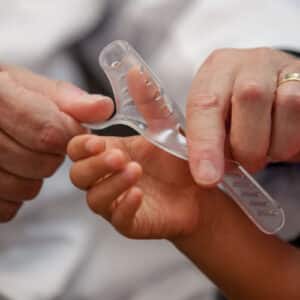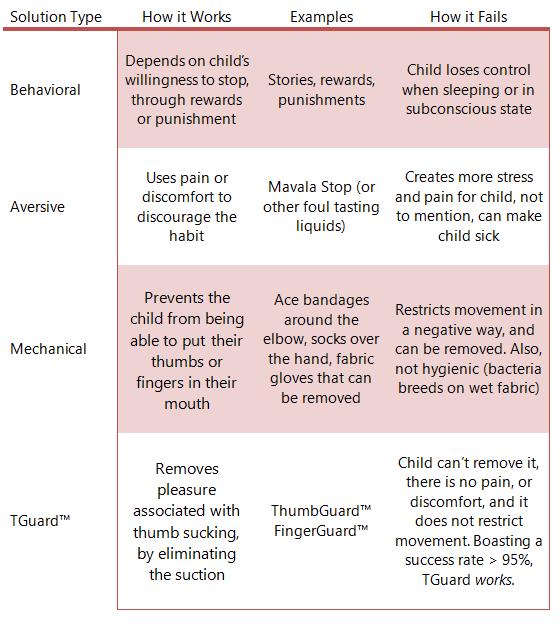Thumb–Sucking Treatment
Most babies suck their fingers or thumb as a natural calming reflex; however, this can become problematic if it persists into adulthood. Constant thumb sucking can alter the shape of the jaw or palate and lead to long-term issues with oral development and speech. The sooner parents learn about thumb–sucking treatment options, the easier it is to prevent the related health concerns.
Thumb or finger sucking is a natural, self-soothing habit for many young children—but if it continues past the toddler years, it can lead to long-term dental, speech, and developmental issues. For parents looking to break the habit, the number of treatment options available can feel overwhelming.
From behavioral rewards to mechanical devices and even uncomfortable orthodontic appliances, there are many approaches—but not all are effective, safe, or child-friendly.
In this guide, we’ll walk you through the most common types of thumb sucking treatments, compare their pros and cons, and explain why TGuard’s gentle, clinically proven solution stands apart as one of the most effective ways to help your child quit for good.
Most Popular Thumb Sucking Treatment Types
Behavioral Treatments: Motivation-Based Approaches
Behavioral methods are often the first step many parents take to handle thumb and finger sucking habits.
These include:
- Rewards systems or sticker charts
- Motivation toys and books
- Support from speech pathologist and child psychologist
While these tools can help raise self awareness and encourage positive behavior during the day, they tend to fall short for nighttime thumb sucking, which happens subconsciously. Therefore behavioral treatments should be paired with other solutions to address subconscious, nighttime thumb and finger sucking.
Aversive Treatments: Creating Discomfort to Deter the Habit
Aversive methods use discomfort or unpleasant sensations to discourage thumb sucking. Common examples include:
- Bitter-tasting polishes applied to the thumb
- Spicy or unpleasant home remedies
- Orthodontic appliances like intraoral cribs or rakes
These solutions can be costly and invasive—particularly dental appliances, which require custom fittings and are fixed in place for 6 to 12 months. They may interfere with speech, eating, and cause discomfort. Less costly home remedies like bitter nail polish or finger coating do not address the underlying physiological habits that cause thumb sucking and children may become distressed when these are tried. For these reasons, aversive treatments are typically considered a last resort by many dental and pediatric professionals.
Mechanical Treatments: Physically Blocking Access
Mechanical approaches aim to prevent children from physically putting their thumb or fingers in their mouth. These include:
- Coverings like mittens, gloves, or socks
- Bandages or wraps
- Arm wraps or splints to restrict elbow movement
While these methods may be effective in the short term, they can also limit the child’s mobility making everyday tasks like eating, writing, or playing more difficult. Mechanical methods are also more difficult to implement at bedtime when subconscious thumb sucking can occur. For some children, this approach can feel restrictive or frustrating.
TGuard: A Unique, Effective Option
Unlike most thumb sucking treatments that rely on discipline, discomfort, or restriction, TGuard offers a completely different solution: it removes the pleasure from thumb sucking, gently and effectively.
Rather than physically blocking the thumb or causing negative sensations, TGuard works by breaking the suction children need to enjoy thumb sucking. Without that feedback, the habit naturally fades away.
Most children break the thumb or finger sucking habit in less than 30 days, and often see improvement within the first week.
What Makes TGuard Different Than Other Treatments
A New Approach to Non-Nutritive Sucking
TGuard’s line of gentle and safe products, such as the AeroThumb and AeroFinger, were developed to effectively stop thumb sucking. Instead of using force and restriction, our design focuses on comfort, freedom, and stopping the habit at the root.
Designed for Comfort, Not Control
Every TGuard device is made from soft, medical grade plastic, the same used for pacifiers and baby bottles. It contains no harmful phthalates or BPA, no toxins, and is manufactured right here in the USA. Because of its light, breathable construction, your child can play, eat, sleep, write, and draw without interference.
Backed by Clinical Success and Parental Success
TGuard is one of the only thumb sucking solutions that’s been clinically evaluated, showing a 90%+ success rate when used as directed. Most parents see noticeable improvement results in just a week, with the full habit resolved in about four weeks.
We are so confident in our product, that we are the only company to offer a 30-day, money-back guarantee, for our US customers.
Looking for more evidence of TGuard’s effectiveness? Check out our testimonials to see positive reviews from hundreds of satisfied customers.
Easy, Gentle, and Child-Approved
TGuard is:
- FDA listed for safety
- Non-Invasive and does not restrict hand movement and day to day activity
- Emotionally neutral, removing the habit without causing shame, discomfort, or distress
Thumb Sucking Treatments FAQs
What types of thumb sucking treatment options exist today?
Thumb and finger sucking treatments generally fall into three main categories:
Behavioral– using rewards or punishments to motivate the child to stop
Aversive – using pain, bad taste, or discomfort as a means to make the act of thumb sucking less pleasurable
Mechanical – using a device to physically prevent thumb sucking from taking place
This chart shows some of the primary treatment types, how they work, examples of products, and why some treatments fall short:
Which treatment method is most effective to stop my child’s thumb sucking habit?
Effectiveness varies depending on the child’s age, personality, and whether the habit occurs mostly during the day or at night.
That said, treatments that address the root cause—comfort and pleasure—tend to work faster and more consistently. This is especially true for nighttime thumb sucking, which happens subconsciously and is harder to control through behavior-based methods alone.
Many parents find that non-restrictive solutions, like TGuard, offer the best balance of comfort, ease of use, and long-term results.
What type of thumb sucking treatments are most effective?
The most effective treatments are those that:
- Don’t rely on conscious effort (important for nighttime habits)
- Are comfortable enough for consistent use
- Don’t cause physical or emotional discomfort
- Allow the child to continue daily activities like eating and playing
TGuard’s approach—removing the pleasure of thumb sucking rather than restricting it—meets all of these criteria and has been clinically shown to work in less than 30 days for most children.
What type of treatment is TGuard?
TGuard doesn’t fit neatly into the traditional behavioral, aversive, or mechanical categories.
Instead, it represents a fourth option: a gentle, non-invasive approach that works by eliminating the pleasure associated with thumb or finger sucking. The device breaks the suction children rely on for soothing, helping the habit fade naturally—without pain, restriction, or stress.
Learn more about how TGuard works here.


